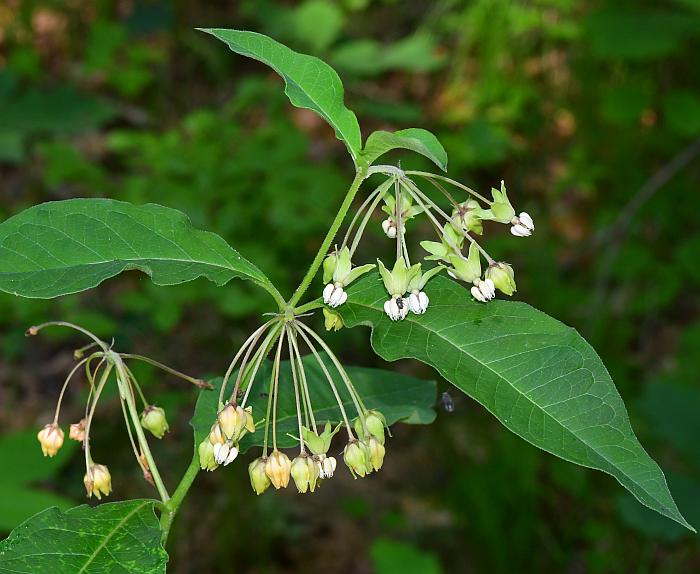Asclepias exaltata L.
Poke Milkweed

Native
CC = 10
CW = 5
MOC = 1
SRank = S1
© SRTurner
Asclepias exaltata L.Poke Milkweed | |
 |
Native CC = 10 CW = 5 MOC = 1 SRank = S1 |
© SRTurner |
|
Family - Asclepiadaceae Habit - Perennial forb. Stems - Erect, to 1.5 m, smooth, glabrous or sparsely pubsecent in longitudinal lines, with milky sap, with 7-11 nodes.
Leaves - Opposite, simple, entire, petiolate. Petioles 1-2 cm. Blades to 30 cm long and 10 cm wide, ovate or broadly elliptic, acuminate at the tip, tapered at the base, dark green above, lighter beneath, glabrous or with short-pubescent undersides.
Inflorescence - Loose umbels, terminal and upper axillary, lax, few-flowered, with spreading or drooping pedicels, these 2-5 cm.
Flowers - Calyx lobes 5, reflexed. Corolla lobes 5, reflexed, pale green, 7-10 mm. Gynostegium appearing stalked (the column visible below the bases of the hoods), the corona approximately as long as the tip of the anther/stigma head. Corona hoods white or pink, 4-6 mm long, the lateral margins terminating in an erect tooth 1.0-1.5 mm long, the hood margins otherwise truncate. Horns white, awl-shaped, conspicuously exserted from corona, arched and converging over tip of anther/stigma head.
Fruits - Follicles 10-15 cm long, erect or ascending from deflexed stalks, lanceolate in outline, pubescent. Seeds flattened, brown, with tuft of hairs at one end. Flowering - May-July. Habitat - Rich, moist woodlands and woodland margins. Origin - Native to the U.S. Lookalikes - None when flowering. Other info. - This species is quite rare in Missouri. At present it is known in the state from only a single population in Cape Girardeau County, discovered by Chris Crabtree in 2010. Otherwise it occurs in the upper Midwest, New England, and into Canada. The plant is easy to recognize by its somewhat lax, drooping, cream colored flowers. A confirming feature is the presence of two prominent teeth at the apex of each hood, as clearly shown in the photos above. Relative to most other milkweeds, the inflorescences tend to be spindly and few-flowered. Photographs taken near Newaygo, Newaygo County, MI, 7-1-2014, and near Loda Lake, Newaygo County, MI, 7-5-2023 (SRTurner). |